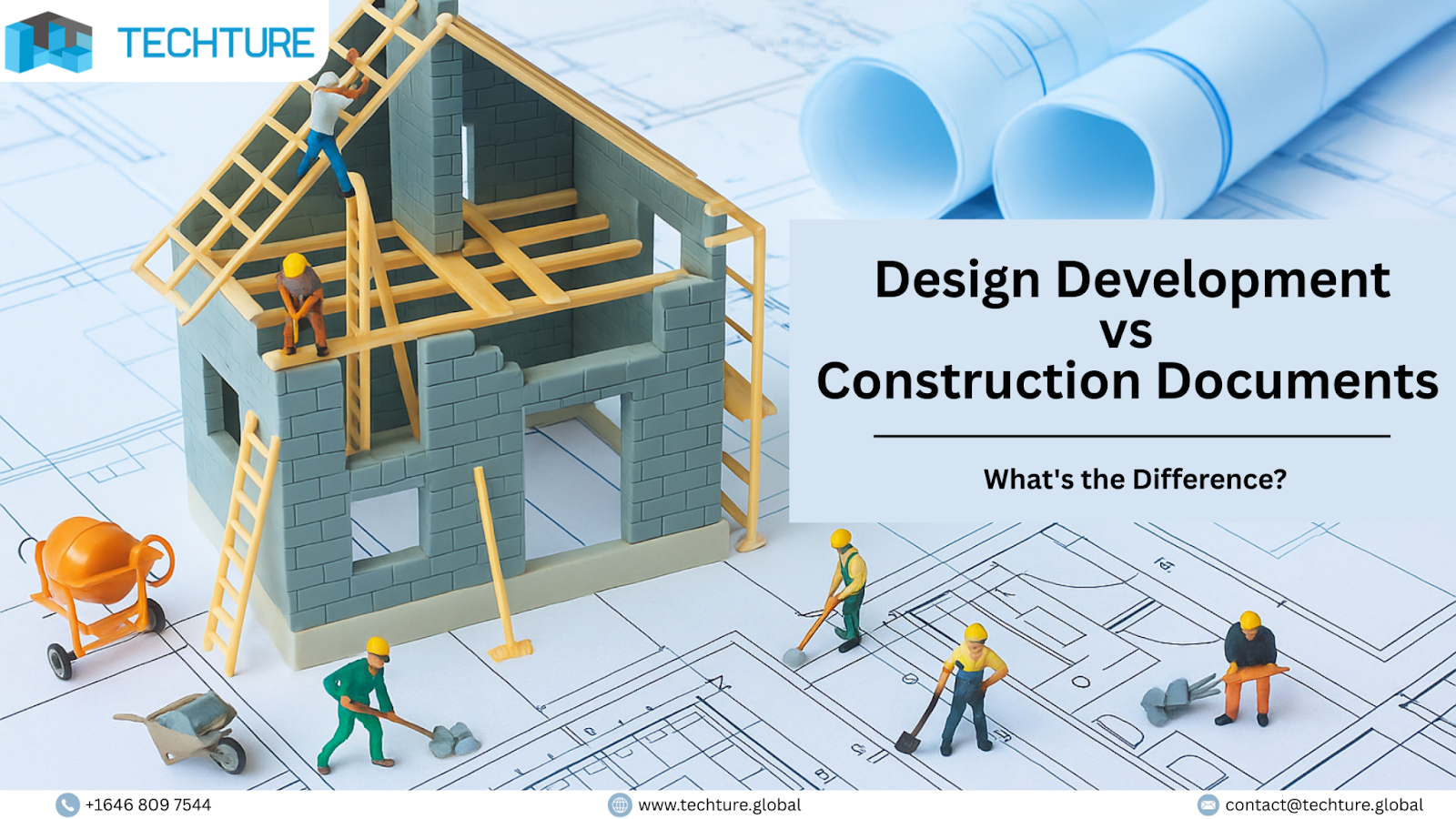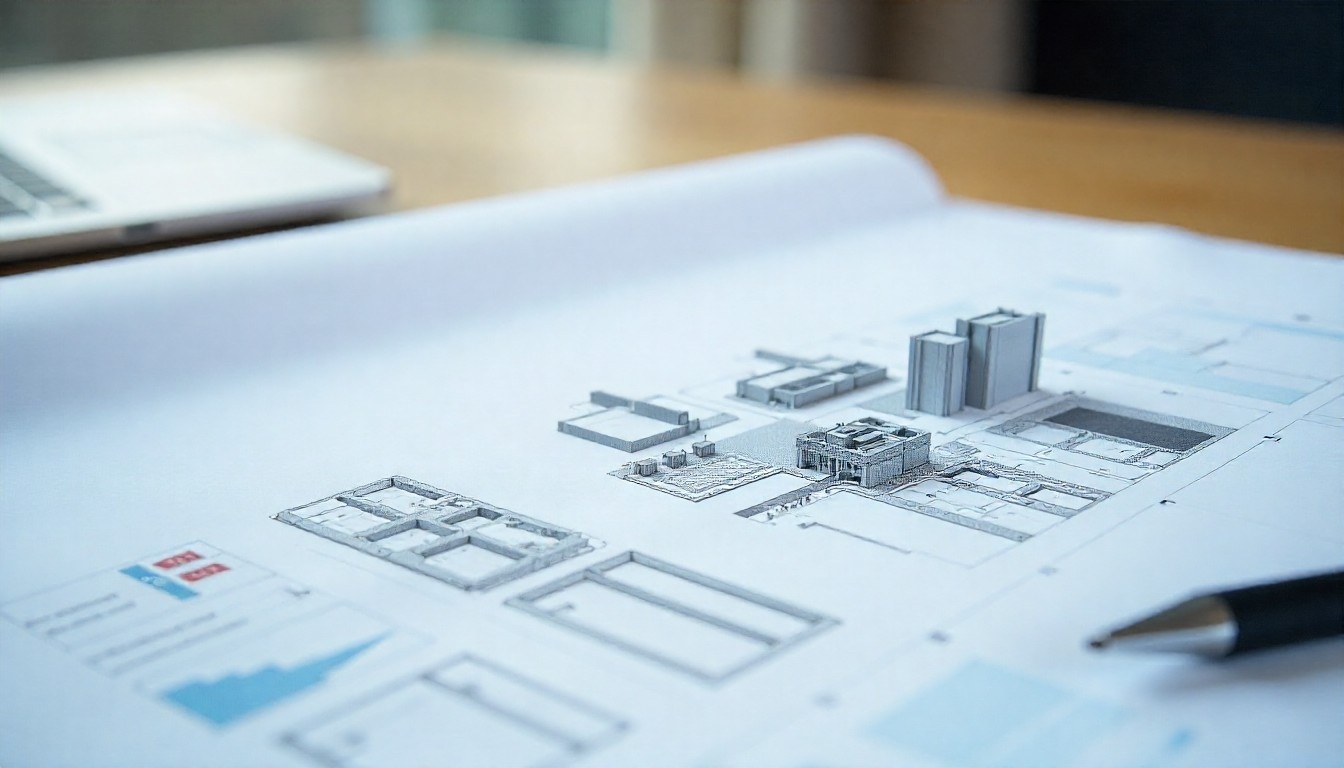
Introduction – Why Understanding Design Development vs Construction Documents Matters
Whether you are building your house, an office, a workplace, or an infrastructure, the successful construction does not begin when the first brick is laid; it actually starts with detailed planning and documentation. In simpler words, we can bifurcate a successful construction into 2 different stages (phases): Design Development (DD) and Construction Documents (CD).
As we divided both into the two different phases of the architectural design, each has its own purpose and importance. The design development refines the design intent, whereas the construction documents bridge the gap between intent and constructibility.
The architects, engineers, and contractors can make a project a real success by ensuring that creative vision and technical feasibility align with the project requirements. When teams clearly distinguish between DD and CD, projects benefit from improved coordination, fewer RFIs, and smoother execution. Resulting in reduced costly design changes, delays, and on-site confusion.
In this article, we will cover all the essential information regarding these two architectural phases, so that you can ensure your project is on track right from the beginning.
What is design development in architecture?

The Design Development (DD) is the stage that converts a Schematic Design (SD) into Construction Documentation (CD). And the stage where the design is refined, tested, and coordinated. During this phase, architects take approved schematic layouts and begin defining dimensions, materials, systems, and specifications. The ultimate goal is to ensure every element, right from structural systems to lighting and HVAC, aligns properly with the design vision and technical feasibility.
Key elements of Design Development (DD):
- Refining spatial layouts: This denotes and tells the actual dimension and project flow.
- Material selection and finishes: Ensuring the project meets the aesthetics and performance requirements.
- Coordination with different disciplines: Ensure seamless communication & coordination with structural and MEP systems to prevent conflicts.
- Preliminary cost estimation: To make sure the design aligns with the project budget.
- Code compliance review: To review, addressing accessibility, fire safety, and zoning requirements.
As soon as we complete the project from the schematic to the design development stage, the design is approximately 60% - 70% complete. And can be taken forward for technical documentation, in the BIM workflow, this is the stage where clash detection begins so that the model is clash-free before we reach the CD stage.
What are Construction Documents?

The Construction Documents (CDs) the the wholesome details and final document that guide the contractors for actual construction. This set of drawings guides contractors and fabricators with every piece of information required to build, budget, and approve the project. The Construction Document phase transforms Design Development into precise technical drawings, including dimensions, materials, tolerances, and performance criteria.
A typical construction document set comprises:
- Architectural plans, sections & elevations.
- Structural & MEP drawings.
- Schedules for doors, windows, finishes, and fixtures.
- Specifications outlining (materials, standards & workmanship).
- Code compliance documentation.
The main purpose of CDs is to permit & execute. The authorities use CDs to evaluate whether the design meets the requirements, and the contractors use CDs as the contractual blueprint for construction.
Design Development vs Construction Documents: Key Differences
So we discussed what design development & construction documents are and at what stage they are used and for what purpose, but to give you a better understanding of how you can differentiate between these two and on what parameter, here is a detailed differentiation.
Why the Design Development Phase Is Important
Ever wonder why the design development phase is so important? You might say it's a phase of converting a schematic into a detailed model, as discussed above. Well, it's true, but the importance of the Design Development doesn't end there; it's a phase where creativity meets technical logic.
Let's understand it a little deeper and discover why the DD phase is so crucial. A strong DD phase ensures:
- The design is aligned with budget constraints.
- To validate Code compliance & constructability early
- Smooth coordination between stakeholders for materials, finishes, and systems.
- Early clash detection through 3D BIM coordination. Resulting in less costly rework.
The above points discussed are the major reasons why the Design Development Phase is so crucial. Proper investment in this stage can help you minimize errors and rework later.
Why Construction Documents Are Critical for Execution
As we discussed, the design development phase is important for coordination and the points discussed. Let's explore why construction documents are critical for execution. In simple words, the construction documents are the backbone of any bundling project, facilitating you with legal, technical, and operational workflow.
To make you understand a little deeper, here are some points why CDs are critical for execution:
- Enable bidding & tendering: Providing a clear scope for contractors to price
- Ensure permit approval by verifying the design meets regulations.
- Guide field execution: Serving as the blueprint for construction.
- Define accountability:
- Reduce ambiguity: By ensuring every detail is documented
Applications Across Project Delivery Processes
The two-phase Design, development, and construction documents play an important role across all architectural delivery models. But these are clearly defined in the Design–Bid–Build (DBB) process. In this traditional workflow, the project goes through a series of structured stages as follows:
- Schematic Design (SD): A stage where the architect develops conceptual layouts & establishes design intent.
- Design Development (DD): The approved schematic design is refined into a coordinated & feasible model.
- Construction Documents (CD): converting the detailed drawings & specifications for bidding, permitting, and construction.
- Bidding: Contractors use the CD to prepare cost proposals.
Pros and Cons of Design Development vs Construction Documents
Every stage has some advantages and limitations, and so do Design Development (DD) and Construction Documents (CDs). In this section, we will discuss the pros and cons of each stage.
Best Practices for Coordinating Design Development and Construction Documents

The coordination from DD to the CDs plays a vital role in ensuring the best possible outcome for a successful project delivery. Here are some practices to ensure a successful coordination, and implementing these practices will ensure a seamless handoff between phases.
- Early Coordination: Involve all the stakeholders (MEP & Structure) early in the DD stage.
- Iterative review cycles: Ensures smooth workflow & improves communication.
- Use BIM: it improves visualisation & early-stage clash detection.
- Standardize templates: maintain consistency across DD & CD.
- Integrate value engineering: optimise cost & performance.
- Maintain version control: keep logs up-to-date to reduce confusion.
Conclusion – Aligning Design, Development, and Construction Documents for Project Success
In this article, we discussed what design development and construction documentation are, right from the theoretical explanation, the different parameters, and pros & Cons, to best practices to coordinate these two seamlessly.
The final verdict would be in the journey of construction; the design development refines the creative vision by integrating technicality to ensure model feasibility. Whereas the construction documents are the road map to make the design development into reality through actionable steps.
FAQs
1. What’s the difference between design development and construction documents?
Design Development focuses on refining and coordinating the design intent, while Construction Documents provide the blueprint for construction.
2. When does the design development phase end and construction documentation begin?
- DD ends when the design intent, materials, and systems are finalized.
- CDs begin after these decisions are made into detailed construction drawings.
3. Who creates design development vs construction documents — architects or engineers?
Architects lead both phases, but engineers (structural, MEP) also contribute during coordination & detailing.
4. Can construction documents be used during the design development phase?
No, it cannot be used during the design development phase.
5. What deliverables do you get at the end of design development?
Floor plans, elevations, material outlines, MEP layouts, and an updated cost estimate.
6. Is BIM used in both design development and construction document phases?
Yes, BIM is used in both DD and CDs phases.




